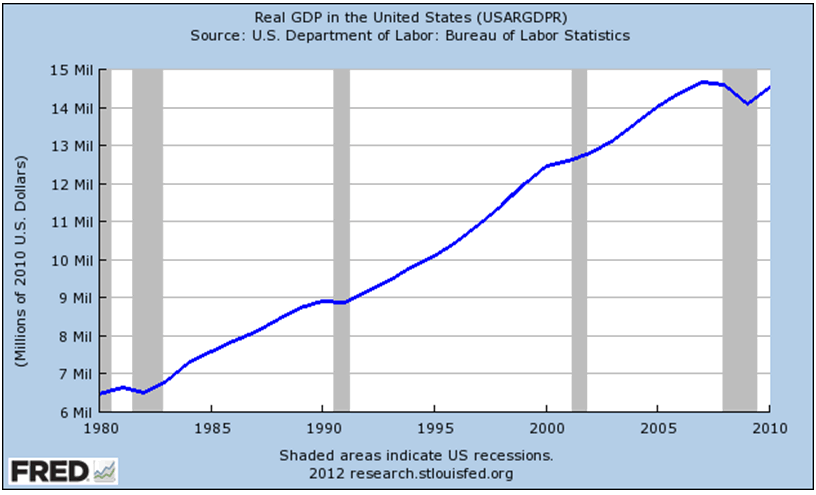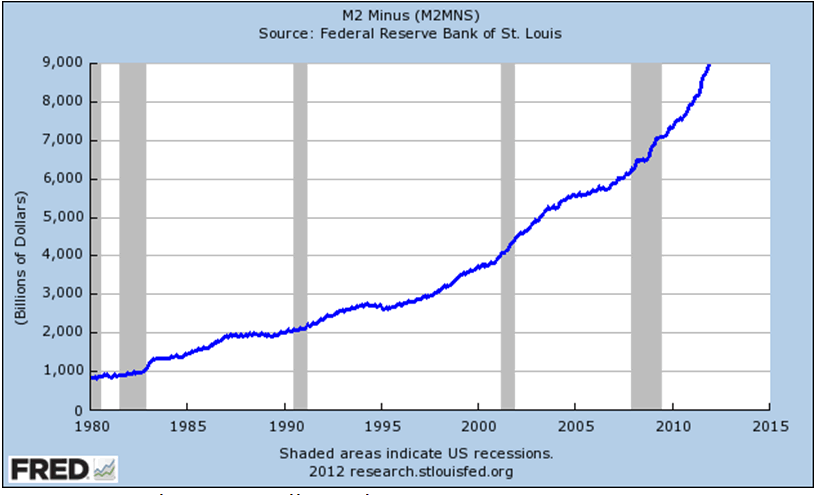The GDP Growth Deception, Central Bank Manipulated Fake Economic Statistics
Economics / Economic Statistics Jan 24, 2012 - 02:49 AM GMTBy: Barry_M_Ferguson
 As 2012 begins, investors need to know the true health of the US economy. A major barometer is the Gross Domestic Product figure. The US economy generates nearly $14.5 trillion dollars annually in Gross Domestic Product or GDP. This is a measure of economic output. When GDP is expanding, we feel good about the economy, our jobs, and our investments. When GDP is contracting, we feel bad about the economy, our jobs, and our investments. Therefore, it is imperative for central bankers and political regimes to foster ever expanding GDP numbers. A happy populace is less likely to revolt and demand new leadership. In our modern information age, everyone knows about the current GDP number. Expansion is good and the economy is growing. Contraction is bad and the economy is in a recession. Thank goodness the GDP number can be rather malleable. And, like everything else in the new era, it can be faked.
As 2012 begins, investors need to know the true health of the US economy. A major barometer is the Gross Domestic Product figure. The US economy generates nearly $14.5 trillion dollars annually in Gross Domestic Product or GDP. This is a measure of economic output. When GDP is expanding, we feel good about the economy, our jobs, and our investments. When GDP is contracting, we feel bad about the economy, our jobs, and our investments. Therefore, it is imperative for central bankers and political regimes to foster ever expanding GDP numbers. A happy populace is less likely to revolt and demand new leadership. In our modern information age, everyone knows about the current GDP number. Expansion is good and the economy is growing. Contraction is bad and the economy is in a recession. Thank goodness the GDP number can be rather malleable. And, like everything else in the new era, it can be faked.
Let’s look at GDP in Chart 1.
Chart 1

US Real GDP
Chart courtesy St. Louis Fed
Looks fine, right? Since 1980, it looks like the US has experienced 5 separate recessions with minor GDP contractions. In all, economic growth is healthy. Currently, the economy is growing. So, the populace is spending more money, buying more stuff, and putting more demand on the supply chain of goods. That’s what we get from Chart 1. Don’t get too excited just yet. Japan’s GDP would show a very similar expansion over the same period. Yet, Japan has supposedly endured decades of malaise that are known as the ‘lost decades’. So, what is GDP and how do we actually measure it?
Let’s define GDP. GDP is basically derived from multiplying money velocity times money supply. Money velocity is measured as the number of times one dollar is used to purchase final goods and services relative to GDP. Therefore, this figure is expressed as a ratio derived from the number of times a dollar changes hands to produce the GDP. Money supply is derived from the so-called ‘M2’ data which is basically the sum of all money deposited in banks. Let’s look at money velocity in Chart 2.
Chart 2

Velocity of M2 Money Stock
Chart courtesy St. Louis Fed
To borrow a phrase from Rick Perry, ‘Ooops!’ The chart showing the velocity of money turnover is declining. That means we are using a dollar less frequently to purchase final products and services. That means the economy should be contracting and activity should be slowing. Economic activity as measured in dollar turnover is declining. In fact, the money velocity rate of turnover is the slowest it has been in over 30 years! Seemingly the US should be in a brutal recession since money velocity should be acting as a drag on GDP. But it is not. Why? Because the other factor in the equation is the money supply. Money velocity times money supply equals GDP.
If we need a positive GDP, and the money velocity is slowing down, we need to have a corresponding increase in the money supply to make this happen. The Fed of course controls to a degree the supply of money with their printing press and their buying or selling of Treasury notes. So, to produce a positive GDP in an period of slowing money velocity, the Fed must increase the money supply. Let’s look at money supply in Chart 3.
Chart 3

M2 money supply minus small time deposits
Chart courtesy St. Louis Fed
To borrow a phrase from Kurt Cobain upon emergence from a suicidal drug overdose coma, ‘Ta-da!’ See, economic activity is not faltering. Really. It is robust. Sure, money is not changing hands very frequently but just look at that rise in the creation of dollars. That’s the secret to positive GDP. Ta-da! Printed and created by thin air. Unfortunately, the money supply increase has been procreated by massive debt. But let’s just stick with GDP for right now. We can confirm that a money velocity rate of 1.6 times a money supply number of $9 trillion gives us a GDP of about $14.5 trillion. We must also understand that the three variables in our formula, money supply, money velocity, and GDP, are just that. They are variables. Money supply can generally be counted and so too can GDP. Money velocity may remain as the unknown and it is therefore solved for by dividing GDP by money supply. Regardless, money velocity may give us a truer indication of economic health than the other two variables.
Now let’s play with the numbers like we are Federal Reserve members high on ink.
- Had the Fed not increased the money supply from the 2008 level of about $6.5 trillion to the current $9 trillion, a money velocity rate at the current 1.6 ratio would produce a GDP of about $10.4 trillion. That’s a 30% smaller GDP than the current pretense. Is it safe to say that our current $14.5 trillion GDP is due to the addition of $4 trillion in extra debt since 2008? Either debt is good or GDP is phoney!
- For perspective, in the mid-1990’s, money velocity was about 2 and money supply was about $3 trillion giving us a $6 trillion dollar GDP. By the end of 2011, GDP has gone up by a factor of 2.5 (thanks to a massive increase in money supply) and money velocity has declined by 25%. Is the economy stronger now than 15 years ago? We can answer that question by acknowledging that unemployment is 2 to 3 times higher today and real incomes are in decline. Suffice to say that national debt has exploded over this time span.
- A 30% drop in GDP would surely signal a depression. Perhaps the present double digit unemployment numbers coupled with the 58% worker participation rate reflects this reality rather than the illusion of wealth perpetrated by GDP figures.
- Pumping up the money supply only to give it to bankers does no good if the money never gets into the hands of the consumers. If the bankers hoard the money, the velocity of turnover is zero. Zero times any number is zero and a GDP at zero does no one any good.
- Poor or negative economic growth tends to make those who possess money opt to keep their money in their pockets. They don’t spend it and they don’t invest it. Therefore, the money velocity gravitates to zero.
- Today’s rate of interest on deposits of money is close to zero. The Fed has now kept the Fed Funds rate at zero for four years. As I have written and spoken over the years, the rate will never go up. It will stay at zero forever. Logically, zero interest rate coupons should serve to force holders of money to spend and invest that money thus creating a higher rate of money velocity. But we are not in Kansas anymore. Perhaps we should see the economy for what it truly is - a ruin in testament to the extinction of capitalism.
- The central banks have stupidly painted us into a corner. Interest rates can never rise. Imagine a scenario in which the Fed began to raise interest rates by raising the Fed Funds rate and selling Treasury holdings. Rising rates would most likely serve to attract more capital in a quest to take advantage of a higher rates relative to stock equity risk. Money velocity would fall further as rising rates would contract the money supply. GDP would nose dive.
- Massive levels of debt, such as the soon to be $16 trillion the US owes, serves to drain the money supply. Someone has to buy all that debt and that is $16 trillion turning over at a velocity of zero. At this point, rising sovereign debt loads necessarily contract the money supply. Central bankers have to work overtime to carry on the illusion of prosperity.
- Massive debt is highly unproductive as it chokes the money supply. A choked money supply constricts an economy and in turn, the money velocity slows down even more. There are only three outcomes. One, the money supply has to be pumped up exponentially Zimbabwe style. Two, the money supply has to be routed to the consumers’ hands who will increase the money velocity. Three, sovereign nations must eliminate debt to free up the money supply. The first two scenarios foster inflation. The last scenario fosters depression in the short term. But, once the shackles of debt are unlocked, capitalism will spur an increase in the velocity of money and the supply can simply be maintained. GDP would then be on a true growth trend. A money velocity at a ratio of 2 with a money supply at $5 trillion yields a GDP of $10 trillion. A money velocity at a ratio of 1 with a money supply of $10 trillion yields a GDP of $10 trillion. The former is far healthier than the latter.
Perhaps the moral to the story is that money velocity is much more important than money supply. Perhaps another moral to the story is that GDP can be faked and manipulated by the central bank.
Barry M. Ferguson, RFC
President, BMF Investments, Inc.
Primary Tel: 704.563.2960
Other Tel: 866.264.4980
Industry: Investment Advisory
barry@bmfinvest.com
www.bmfinvest.com
www.bmfinvest.blogspot.com
Barry M. Ferguson, RFC is President and founder of BMF Investments, Inc. - a fee-based Investment Advisor in Charlotte, NC. He manages several different portfolios that are designed to be market driven and actively managed. Barry shares his unique perspective through his irreverent and very popular newsletter, Barry’s Bulls, authored the book, Navigating the Mind Fields of Investing Money, lectures on investing, and contributes investment articles to various professional publications. He is a member of the International Association of Registered Financial Consultants, the International Speakers Network, and was presented with the prestigious Cato Award for Distinguished Journalism in the Field of Financial Services in 2009.
© 2012 Copyright BMF Investments, Inc. - All Rights Reserved
Disclaimer: The views discussed in this article are solely the opinion of the writer and have been presented for educational purposes. They are not meant to serve as individual investment advice and should not be taken as such. This is not a solicitation to buy or sell anything. Readers should consult their registered financial representative to determine the suitability of any investment strategies undertaken or implemented.
© 2005-2022 http://www.MarketOracle.co.uk - The Market Oracle is a FREE Daily Financial Markets Analysis & Forecasting online publication.



